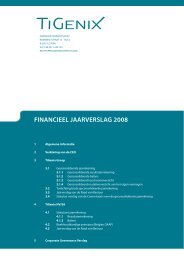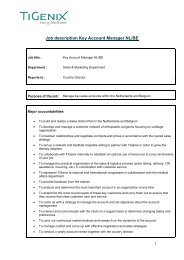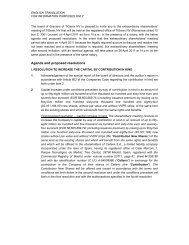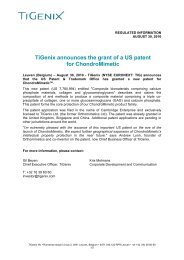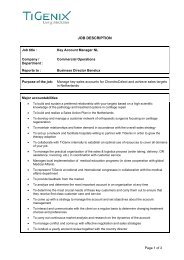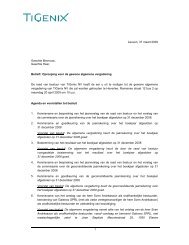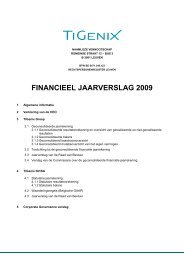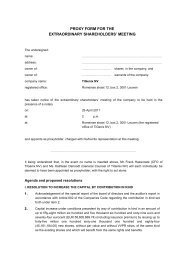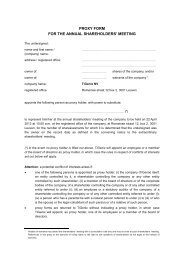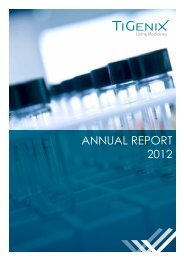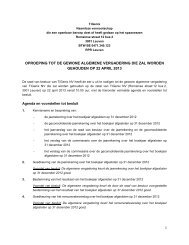ANNUAL FINANCIAL REPORT 2010 2010 - TiGenix
ANNUAL FINANCIAL REPORT 2010 2010 - TiGenix
ANNUAL FINANCIAL REPORT 2010 2010 - TiGenix
- No tags were found...
You also want an ePaper? Increase the reach of your titles
YUMPU automatically turns print PDFs into web optimized ePapers that Google loves.
Preclinical work in a meniscus repair model has demonstratedthe biological activity of the MSC product and therebyillustrated the feasibility of the selected approach andconfirmed that transplanted cells are integrating into the nativetissue proving the biological principles to be translatable to theorthotopic situation and indicated the safety of an allogeneicapproach. Currently, the Company is further optimizing itspre-clinical models to obtain confirmatory safety and proof ofprinciple that is required to initiate clinical trials.Osteoarthritis (“OA”)OA, also known as degenerative joint disease, is a very commondisease that is associated with the loss of the ability of jointtissue to repair and maintain itself. OA particularly affectstissues such as articular cartilage and underlying bone, andprogression of the disease is the result of several biomechanical,biological and genetic factors. OA is one of the major causesof pain in Western populations and in the US is second onlyto ischemic heart disease as a cause of disability 27 . About6% of adults over age 30 and 12% of adults over age 55 haveradiographic evidence of OA and complain of frequent jointpain and loss of function. Another 6% of adults over age 30 and12% of adults over age 55 do not show radiographic evidenceof OA although they complain often of joint loss and painindicating an initial phase of (mild) OA 28 . The World HealthOrganization (WHO) estimates that, worldwide, 9.6% of menand 18% of women aged over 60 years have symptomaticosteoarthritis 29 . All together, the total number of peopleaffected by OA in Japan, the US and major markets in Europe(France, Germany, Italy, Spain and the UK), is estimated toextend 80 million of which 45 million are diagnosed and dueto the increasing activity of both the elderly and the youngerpopulation, the disease is growing steadily.Looking at the current treatment options for OA, it is clearthat most treatments today are symptomatic and palliativewith an emphasis on control of joint pain and maintenance offunction, including rectification of mechanical malalignmentand addressing other manifestations of joint instability. Thenon-pharmacological interventions are mostly preferred asa first line option as toxicity and adverse event profiles of themost commonly used current pharmacological treatments(e.g. NSAIDS or COX2 inhibitors) are unfavourable. This poses ahuge unmet medical need and opportunity for developmentof novel approaches and medicines to treat OA, especiallyfor disease modifying therapies that can halt and/or reversethe onset and delay the progression of the disease. As statedabove, the incidence of OA is high and the market opportunityand potential is enormous. Even when only focusing on mildand moderate OA in patients of 60 years or younger wherea therapeutic intervention will have the best impact, thepotential is still several million patients a year in the mostimportant European, US and Japanese markets. This, combinedwith the current lack of an efficient disease-modifying therapyand the possible need for a repeated therapeutic intervention,makes OA an attractive indication for a sustainable growthscenario for <strong>TiGenix</strong>.Acquisition of CellerixAs a result of the Contribution, the Company acquired all sharesin Cellerix. Further details on the market opportunity of Cellerixare provided in section 6.14.4.Moreover, as well as having an impact on the individual, itimpacts heavily on the economy. It has been estimated thatosteoarthritis costs the US economy $60 billion a year 30 . In 2005,hospitalisations for musculoskeletal procedures in the US costa total amount of $31.5 billion, accounting for more than 10%of all hospital care 31 . These numbers do not include the highindirect costs (e.g. loss of wages and productivity) beside thedirect medical costs.27 Arden, N. & Nevitt, M. C., Best Pract Res Clin Rheumatol, 20(1) 3-25, 200628 Datamonitor, 200929 2003, www.who.int/bulletin30 Buckwalter, J. A., Saltzman, C., & Brown, T., Clin. Orthop. Relat. Res (427) Suppl,S6-15, 200431 Gabriel, S. E. & Michaud, K., Arthritis Res. Ther, 11(3), p.229, 2009114 • <strong>TiGenix</strong> • Rights Offering



